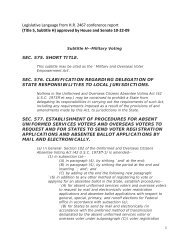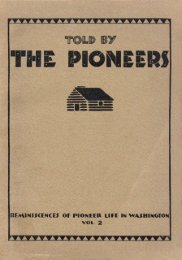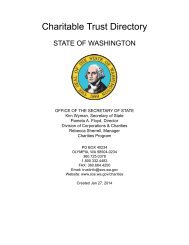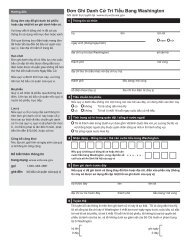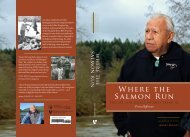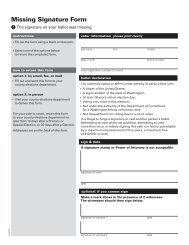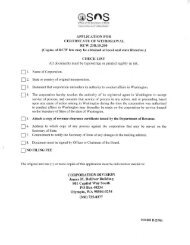TOLD by the PIONEERS - Washington Secretary of State
TOLD by the PIONEERS - Washington Secretary of State
TOLD by the PIONEERS - Washington Secretary of State
You also want an ePaper? Increase the reach of your titles
YUMPU automatically turns print PDFs into web optimized ePapers that Google loves.
Told <strong>by</strong> <strong>the</strong>P'ioneers<br />
papers. The furniture was crude and mostly home-made, mattresses<br />
were filled with straw and bunch grass. Fuel was mostly sage brush<br />
which grew in abundance on <strong>the</strong> prairie. Clothing was <strong>of</strong> rough denin<br />
and <strong>the</strong> cheapest <strong>of</strong> split lea<strong>the</strong>r work shoes. Transportation was<br />
<strong>by</strong> wagon and horseback, and some used <strong>the</strong> recently completed railroad,<br />
providing <strong>the</strong>y could afford <strong>the</strong> fare. The food was very plain,<br />
but substantial, as <strong>the</strong> farmers raised most <strong>of</strong> <strong>the</strong>ir own vegetables<br />
and had plenty <strong>of</strong> livestock for meat.<br />
MRS. O. G. FRANCE (Mam-ie Irene Blair)<br />
Chelan County<br />
In 1889-90, during <strong>the</strong> cattle-killing winter, <strong>the</strong>re was no flour in<br />
<strong>the</strong> valley. My fa<strong>the</strong>r rode into Ellensburg and brought back twenty<br />
sacks on a sort <strong>of</strong> land raft made <strong>of</strong> logs, and which was dragged Indian<br />
fashion over <strong>the</strong> Pass.<br />
P. B. BATEMAN<br />
Columbia County<br />
Each fall we chinked our old log house with mud. O<strong>the</strong>r preparations<br />
for winter consisted <strong>of</strong> filling <strong>the</strong> root cellar with vegetables,<br />
apples, preserves, and pickles, put up <strong>by</strong> <strong>the</strong> women. There was no<br />
way <strong>of</strong> canning' known to us at that time. We dug a trench and filled<br />
it with cabbages, leaving <strong>the</strong> tips <strong>of</strong> <strong>the</strong> roots sticking out so we could<br />
•<br />
locate <strong>the</strong>m. Such crisp cabbage we had all winter!<br />
The Palouse, Lapwai and Umatilla Indians traveled <strong>the</strong> old trails,<br />
visiting back and forth. Some <strong>of</strong> <strong>the</strong> old trails over <strong>the</strong> hills are still<br />
visible. The Indians tied two long poles at one end and set this end<br />
in front <strong>of</strong> <strong>the</strong>ir saddle horn, leaving <strong>the</strong> o<strong>the</strong>r ends <strong>of</strong> <strong>the</strong> poles Oil<br />
<strong>the</strong> ground behind <strong>the</strong> pony. A buffalo robe was tied between <strong>the</strong><br />
poles to form a sort <strong>of</strong> basket for <strong>the</strong>ir packs and <strong>the</strong> children too<br />
small to ride ponies. The squaws would mount <strong>the</strong>ir ponies and away<br />
<strong>the</strong>y would go, <strong>the</strong> children riding safely in <strong>the</strong>ir buffalo-robe basket.<br />
One <strong>of</strong> <strong>the</strong> most interesting sights that I can now recall was a Chinese<br />
pack train. There was a small band <strong>of</strong> <strong>the</strong>se little yellow roell,<br />
probably ten or fifteen. Each had a bamboo pole, probably six or<br />
seven feet in length and four or five inches in diameter. On each end<br />
<strong>of</strong> this pole was a basket holding fifty or sixty pounds, packed with<br />
rice, bacon and tea.<br />
120



